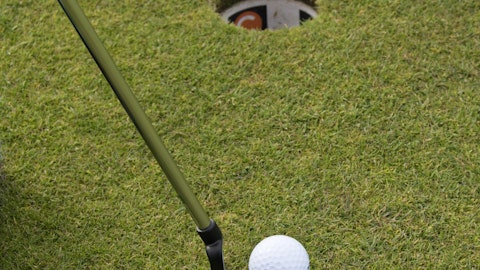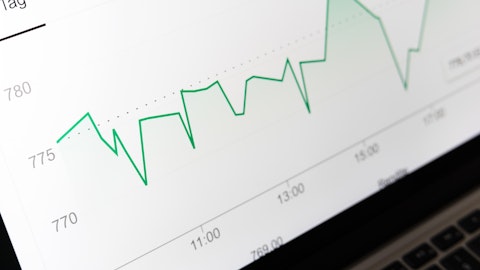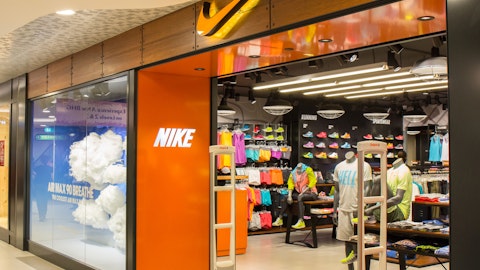Acushnet Holdings Corp. (NYSE:GOLF) Q3 2023 Earnings Call Transcript November 3, 2023
Operator: Good morning, everyone, and welcome to the Acushnet Holdings Corp. Third Quarter 2023 Earnings Conference Call. My name is Carla, and I will be your operator for today’s call. [Operator Instructions] I will now hand over to your host, Sondra Lennon, Vice President of Planning, Analysis and Investor Relations, to begin. Sondra, please go ahead.
Sondra Lennon: Good morning, everyone. Thank you for joining us today for Acushnet Holdings Corp.’s third quarter 2023 earnings conference call. Joining me this morning are David Maher, our President and Chief Executive Officer; and Sean Sullivan, our Chief Financial Officer. Before I turn the call over to David, I would like to remind everyone that we will be making forward-looking statements on the call today. These forward-looking statements are based on Acushnet’s current expectations and are subject to uncertainty and changes in circumstances. Actual results may differ materially from these expectations. For a list of factors that could cause actual results to differ, please see today’s press release, the slides that accompany our presentation and our filings with the U.S. Securities and Exchange Commission.
Throughout this discussion, we will make reference to non-GAAP financial metrics, including items such as revenues at constant currency and adjusted EBITDA. Explanations of how and why we use these metrics and reconciliations of these items to a GAAP basis can be found in the schedules in today’s press release, the slides that accompany this presentation and in our filings with the U.S. Securities and Exchange Commission. Please also note that references throughout this presentation to year-on-year sales increases and decreases are on a constant currency basis unless otherwise stated as we feel this measurement best provides context as to the performance and trends of our business. And when referring to year-to-date results or comparisons, we will refer to the nine-month period ended September 30, 2023, and the comparable nine-month period.
With that, I’ll turn the call over to David.
David Maher: Thanks, Sondra. And good morning, everyone. We appreciate your interest in today’s call. I will start on Slide 4 and get right into our results. Acushnet posted third quarter sales of $593 million, a 6% increase over last year. Adjusted EBITDA for the period was up 14% to $99 million. For September, net sales were up 10% to almost $2 billion, while adjusted EBITDA increased 21% to $378 million. I will pause here to thank my teammates for their commitment and dedication, which fuels the company’s performance. Looking at our business by segment, you see the strength and momentum of Titleist Golf Balls and Golf Clubs, driving the company’s growth. Titleist Golf Balls were up 6% in the quarter and 16% year-to-date. New Pro V1 and Pro V1x models are leading this growth and our golf ball manufacturing team is doing good work to keep pace with strong consumer demand.
As we approach the holiday retail season, our golf ball availability position is healthy, and we have transitioned to building inventory to support new product launches scheduled for early 2024. And across the worldwide tours, Titleist Golf Ball usage is more than seven times the nearest competitor and at the Men’s and Women’s U.S. Open and Open Championships, all four winners played a Titleist Golf Ball, four different champions, winning majors on four distinctly different golf courses, showcase the quality, total game performance and versatility that define the number one ball in golf. Moving to Titleist Golf Clubs, our team posted another strong quarter with sales up 18% for the period and 17% year-to-date. New Titleist T-Series irons launched in August and are off to a solid start with early demand meeting our high expectations.
Titleist was the most played iron on the PGA Tour this past season for the 19th time in the past 20 years, and Titleist TSR drivers also continue their streak as the most played driver on tour. Rounding out our club business, we are also pleased with the momentum and sustained demand for Vokey wedges and Scotty Cameron putters across the worldwide tours and in the marketplace. And affirming their global strength, Titleist Golf Balls and Golf Clubs have posted year-to-date sales gains in all regions. Now moving to Gear, you see sales were down 20% in the quarter and up 9% year-to-date. This third quarter decline was expected as we comped against last year’s outsized growth when much of our gear volume was delayed into Q3 as a result of supply chain disruptions we experienced in the first half of 2022.
We are pleased that our gear delivery and service have returned to healthy levels and that the timing of our business is on a normalized and demand-driven cadence. Now to FootJoy, sales increased 3% in the quarter and are flat year-to-date due mainly to the strength of our U.S. business. Growth in the quarter was led by apparel and a modest increase in footwear as we effectively differentiate our new golf shoe products in a crowded retail environment. Affirming our comments on the last call, we expect the industry will continue to work through excess footwear inventories for the next few quarters, and we remain confident that our team will manage through this period while protecting FootJoy’s premium positioning and long-term interests. Now to Slide 6 and look at our business by region, here, you see the strength of the U.S. market and consumer in our quarterly and year-to-date results.
The U.S. is setting the pace with rounds of play up 4% year-to-date and on track to surpass their previous high mark from 2021. We see this as positive commentary on the overall health of the sport and the additive impact of the expanding golfer base. Healthy participation and strong demand across our portfolio are driving Acushnet’s 8% third quarter and 15% year-to-date growth in the U.S. Golf balls, clubs and shoes were up double digits year-to-date, whileGear and FootJoy have posted high single-digit gains for the period. Outside the U.S., we estimate that rounds in EMEA, Japan and Korea were off low single digits through September, largely attributable to unfavorable weather compared to last year. Acushnet year-to-date sales, as you see, are off 1% in EMEA, up 9% in Japan and down 2% in Korea, Rest of World sales have increased 14%.
As noted, ball and club sales are up in all regions, while footwear declines and a soft apparel market in Korea has negatively impacted both Titleist and FootJoy apparel sales. And now looking forward, the attractiveness of Acushnet’s core consumer, the game’s avid and dedicated player and the company’s enduring commitment to product and service excellence continue to drive the strong financial performance and positive outlook we share today. We’re enthused with the momentum behind our Titleist, FootJoy and Shoes brands and healthy market fundamentals and are confident in the investments we are making across our businesses to position Acushnet for sustaining leadership and growth. Golf participation is vibrant with worldwide rounds of play tracking ahead of their 2021 peak, and golf courses and retail partners are investing in their facilities and experiences to meet evolving consumer preferences.

On the new product front, we’re optimistic about early interest in our new T-Series irons and are confident our custom fitters and supply chain will support high-quality golfer experiences and our ability to meet anticipated demand levels. Our golf ball team is on track to launch several new models in early 2024. Remember, in even years, we launched new AVX and performance models. We have high confidence in the health of our supply chain and ability to successfully execute these launches and also look to benefit from recently added capacity, which will support improved Pro V1 availability going forward. We’re equally confident in the state of our new product pipelines for Titleist Gear, FootJoy and Shoes and are well positioned to meet the anticipated Q4 and holiday demand and launch a wide range of new products next quarter.
In summary, we believe the company’s commitment to making high-performance, high-quality golf products, focus on the game’s dedicated golfer, proven track record of product innovation and supply chain management and ongoing investment in our product development, golfer connection and manufacturing, will support the company’s long-term growth objectives. These priorities, along with the company’s disciplined approach to capital allocation, remain the foundation of Acushnet’s proven investment thesis. Thanks for your time this morning. I will now pass the call over to Sean.
Sean Sullivan: Thank you, David. Good morning, everyone. As David highlighted, we had a great quarter and strong year-to-date performance. Third quarter net sales increased 6% over the same period in 2022, driven by higher sales in Titleist Golf Clubs, Titleist Golf Balls and FootJoy Golf Wear. Adjusted EBITDA was $99 million, a 14.2% increase. For the first nine months of 2023, net sales and adjusted EBITDA increased 9.9% and 20.6%, respectively. Net sales growth in the quarter was driven by continued momentum of our Titleist brand with Golf Clubs and Golf Balls growing by 17.9% and 6.2%, respectively. FootJoy sales were also up in the quarter by 3.4% driven mainly by apparel. Titleist Golf Gear decreased by 19.9% from the third quarter of 2022, which, as David mentioned, reflects a comparison to the outsized quarter we had last year.
Net sales were up in Q3 across all regions, except for Korea, where the market continues to be impacted by soft footwear and apparel sales. Gross profit in the quarter was $309 million, up 4.6% compared to 2022, primarily due to higher sales volumes in Titleist Golf Clubs, higher average selling prices in Titleist Golf Balls and lower inbound freight across all reportable segments. Titleist Golf Gear gross profit was down mainly due to lower sales volumes and FootJoy gross profit was down primarily due to unfavorable manufacturing overhead absorption and increased promotional activity in footwear. Overall gross margin of 52% was down 80 basis points, largely due to the FootJoy factors, I just mentioned, primarily offset by lower inbound freight costs across all reportable segments.
SG&A expense of $210 million in the quarter increased $8 million or 3.8% from 2022, mainly due to higher advertising and promotion expenses in Titleist Golf Clubs and Titleist Golf Balls, higher selling expense primarily due to employee-related expenses, partially offset by lower retail commission expense in Korea and lower IT-related expenses. R&D expense of $16 million was up mainly due to higher employee-related expenses. Our increase in intangible amortization was due to the acquisition of trademarks related to Titleist Golf Clubs and Golf Gear in the fourth quarter of 2022 and the first quarter of 2023, respectively. Interest expense of $9 million in the quarter was up $5 million due to an increase in borrowings and interest rates with a little more than half the increase coming from higher debt balances.
Our effective tax rate in Q3 was 16.5%, down from 22.9% last year, primarily driven by a shift in our mix of jurisdictional earnings. Our forecasted effective tax rate for fiscal year 2023 is expected to be in line with our year-to-date rate of approximately 19%. Moving to our balance sheet and cash flow highlights. Our balance sheet and cash flow positions continue to be very strong, allowing us to continue to execute our capital allocation strategy with ongoing investments in the business and return of capital to shareholders being our highest priorities. I am pleased to report that on October 3, 2023, we completed the issuance and sale of $350 million of 7.38% senior unsecured notes due in 2028, which further enhances Acushnet’s liquidity position.
The proceeds in the notes offering were primarily used to repay borrowings under our revolving credit facility. Our net leverage ratio at the end of Q3 was 1.6 times. Inventories declined from both last quarter and year-end, and we are comfortable with our inventory quality and net position given the current state of demand and the supply chain. We expect inventories to increase at year-end to support 2024 product launches. Year-to-date cash flow from operations was up significantly from the prior year, mainly due to changes in working capital, primarily inventory. Capital expenditures were $42 million in the first nine months of 2023 and are still expected to reach approximately $75 million in fiscal year 2023, given a heavily loaded Q4 pipeline.
Through September, we returned roughly $245 million to shareholders in 2023, with $205 million in share repurchases and $40 million in cash dividends. Today, our Board of Directors declared a quarterly cash dividend of $0.195 per share payable on December 15 to shareholders of record on December 1. As of September 30, we had $202 million remaining under the current share repurchase authorization. Between October 1 and October 27, 2023, we purchased approximately 386,000 shares of our common stock on the open market for an aggregate of $20.2 million, bringing the cumulative total open market purchases since the inception of the 2023 share repurchase agreement with Magnus to $100 million. As a result, we expect to purchase approximately 1.8 million shares of our common stock from Magnus for an aggregate of $100 million on November 3, 2023, in satisfaction of our commitment under the 2023 agreement.
After settlement of this agreement, we will have approximately $82 million remaining under the share repurchase authorization. Turning to our full year 2023 outlook, we’re maintaining our view for revenue to be between $2.35 billion and $2.4 billion, up 5% to 7.2% on a constant currency basis compared to 2022. This outlook incorporates continued momentum in the golf ball and golf club categories. However, some of our third quarter outperformance in golf clubs was due to timing, notably in Japan, where this year’s iron launch was a quarter earlier than last year’s fourth quarter metal launch. At the midpoint, our revenue would be up 6.1% on a constant currency basis. With respect to adjusted EBITDA, we are narrowing our range to be between $365 million and $375 million.
In terms of the fourth quarter, on top of the shift of golf club revenue to Q3, I just mentioned, I also want to point out that our outlook reflects incremental investments in the fourth quarter, in particular, selling, R&D and A&P as we look to build upon momentum heading into 2024. In closing, we’re very pleased with our performance in the first 9 months of 2023 and remain focused on executing on our priorities for the balance of the year and beyond. With that, I will now turn the call over to Sondra for Q&A.
Sondra Lennon: Thank you, Sean. Operator, could we now open up the lines for questions?
See also Top 20 Countries with the Highest Percentage of Smokers and Top 20 Countries With Least Smokers.
Q&A Session
Follow Golfsmith International Holdings Inc
Follow Golfsmith International Holdings Inc
Operator: Absolutely. [Operator Instructions] We will now take our first question today from Randy Konik from Jefferies. Randy your line is now open, please go ahead.
Randy Konik: Yes, thanks. And good morning, everyone. I guess Sean, just real quick to clarify, is there any way to quantify the impact of that shift in Japan from fourth quarter into third quarter? Just give us a little flavor there. And then, I guess, David, just give an update on just market thoughts by region. The U.S. market continues to power ahead even with very wet weather. So, that’s very positive. Just wanted to get your thoughts just how you feel about the U.S. market relative to Europe and Asia at this point in the cycle?
David Maher: Hi, Randy. I’ll take that. So U.S. certainly point to rounds of play, obviously healthy. I think we’re on track to be – we’re up about 4% year-to-date, which set against the backdrop of a very wet spring in open markets, particularly the West. I think the industry generally feels really good about what we’re seeing in participation. So U.S. participation, up low single, outside the U.S., down low single in terms of rounds play. And that’s got a bit of a weather impact as well. I think when I looked at the third quarter rounds profile outside the U.S. it was flat to up 1%. So, U.S. outpacing in rounds. And I would say U.S. outpacing in consumer spending as well, which I don’t think surprises any of us. We certainly saw a bit of a pullback from the consumer in Europe this year, which we expected.
Japan, little bit like Europe. The one area that may be a bit of an outlier is Korea, where we called that out on our prepared remarks with the apparel space in the Korean market. But by and large, very happy with participation, particularly in the U.S., pleased with consumer spending in the U.S. and would note that a slight trailing outside the U.S., both in terms of rounds of play and consumer spending. But where we sit today with the market where it is, with consumer spending where it is, I think it just speaks to the strength and resilience of the sport. And then when you refine that a bit into our dedicated golfer, you see that group as even more resilient than the broader consumer space.
Sean Sullivan: Yes. And then Randy, on your first question about the clubs, again, we are obviously very pleased with how the irons launch has gone. When you look at Japan in Q3 this year versus last, we’re probably up about $5 million in the region. And certainly, we’re comping. And I think the key point here is we’re comping against a metals launch that happened in Q4. So it’s as much about what you should expect in Q4 as what we experienced in Q3.
Randy Konik: And then last follow-up. Just Sean, again for you, just on gross margin. Can you just walk us through some of upcoming puts and takes you expect just to impact gross margin ahead? It sounds like there’s still ASP strength. Freight rates are down. I don’t know if raw materials are as well or labor. Just want to get your thoughts on how we should be thinking about just trends around, again, the puts and takes around gross margin? Thanks guys.
Sean Sullivan: Yes, sure. So I feel very good about the gross margin outlook. I think on the positive side, we have experienced benefits in 2023 from freight, as you called out. I think the majority of that, Randy, we have experienced through the nine months. I think as I look at Q4, probably a small tailwind on freight relative to prior year, but I think moving to a more normalized state. We talked about the strength of the ball and the club segment. So I think that will continue to bolster the gross margin. And on the flip side, again, we’ve talked about our customization, our distribution. We’ve talked about manufacturing overhead. So, in many respects, the footwear category and what impact our production and manufacturing has as it was in the quarter, a bit of a drag.




